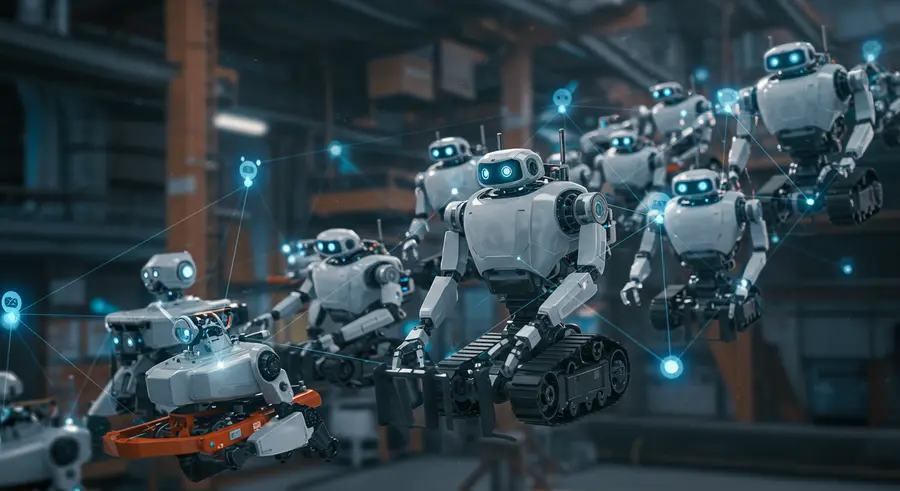Appearance
Orchestrating Autonomy: Advanced Robotic Task Allocation for Collective Intelligence
In the burgeoning field of robotics, the ability for multiple robots to work together seamlessly is not merely an advantage—it's a necessity. This collaborative potential hinges on a sophisticated discipline known as Robotic Task Allocation, or more specifically, Multi-Robot Task Allocation (MRTA). This isn't just about assigning duties; it's about orchestrating a symphony of autonomous agents to achieve complex goals with optimal efficiency and resilience.
The core challenge in MRTA lies in effectively distributing a set of tasks among a team of robots, often with diverse capabilities, in dynamic and uncertain environments. Imagine a warehouse where autonomous mobile robots need to fulfill orders, or a disaster zone where drones must cooperatively map damaged areas and identify survivors. In such scenarios, efficient task assignment is critical to overall system performance.
The Pillars of Multi-Robot Task Allocation
At its heart, MRTA addresses the fundamental questions: Which robot should do what task? and When should they do it? The answers are rarely straightforward, given the complexities of real-world operations, including:
- Heterogeneous Robot Capabilities: Not all robots are created equal. Some might be faster, some stronger, others equipped with specialized sensors.
- Dynamic Environments: Tasks can appear or disappear, environmental conditions can change, and robots might fail.
- Inter-dependencies: Some tasks might require others to be completed first, or multiple robots might need to collaborate on a single task.
- Optimization Objectives: The goal could be to minimize total time, maximize task completion, reduce energy consumption, or a combination thereof.
To tackle these challenges, researchers have developed a variety of algorithmic strategies. These methods aim to overcome the NP-hard nature of the underlying optimization problems, meaning that finding the absolute best solution can become computationally impossible as the number of robots and tasks grows.
Key Algorithmic Approaches to Task Assignment
Several powerful paradigms underpin modern Robotic Task Allocation systems:
1. Auction-Based Mechanisms
Inspired by economic principles, auction-based approaches allow robots to "bid" on tasks. Each robot assesses a task's cost (e.g., time, energy) to itself and submits a bid. The task is then awarded to the robot with the lowest bid. This decentralized approach fosters distributed decision-making, reducing the need for a central coordinator, which can be a single point of failure.
- Pros: Highly scalable, robust to individual robot failures, adaptable to dynamic changes.
- Cons: Can be computationally intensive for complex tasks, susceptible to "local optima" if not carefully designed.
2. Fuzzy Logic for Autonomous Decision-Making
Fuzzy logic provides a way to handle uncertainty and imprecision, common in real-world robotic deployments. Instead of rigid true/false conditions, fuzzy logic allows for degrees of truth. For task allocation, this means robots can make more nuanced decisions about task suitability based on a range of factors (e.g., "very close," "moderately busy," "slightly damaged"). This allows for autonomous task selection without centralized control, increasing flexibility in real-time operations.
Pros: Robust to noisy sensor data and uncertain environments, mimics human-like reasoning.
Cons: Requires careful definition of fuzzy rules, can be difficult to verify and validate.
3. Genetic Algorithms (GAs) for Optimization
Genetic algorithms are optimization heuristics inspired by natural selection. They are particularly well-suited for complex, multi-objective task distribution problems. A population of potential task assignments "evolves" over generations, with fitter solutions (those closer to the optimal objective) being selected, mutated, and combined to produce new, improved solutions.
- Pros: Can find good solutions for highly complex and non-linear problems, less prone to getting stuck in local optima compared to greedy approaches.
- Cons: Can be computationally expensive, especially for large problem spaces, and doesn't guarantee the absolute optimal solution.
Beyond the Basics: Emerging Trends and Hybrid Approaches
Recent advancements in MRTA are pushing the boundaries further. Researchers are incorporating more complex constraints, such as temporal logic specifications (e.g., "task A must be completed before task B"), and exploring proactive allocation under uncertainty, where task arrival times and locations are not precisely known.
The integration of machine learning, particularly deep reinforcement learning, is also gaining traction. These systems learn optimal task assignment policies through trial and error, allowing robots to adapt their behavior in response to environmental changes or the actions of other robots.
Visualizing Robotic Task Allocation
To better understand the dynamics of robot team coordination, consider this conceptual diagram of a swarm of robots engaged in distributed task allocation:

Image: A conceptual representation of robotic task allocation in a collaborative swarm.
In this visual, the glowing lines represent the dynamic communication and task allocation pathways. Each robot, while seemingly independent, is part of a larger collective intelligence, constantly negotiating and re-assigning responsibilities to optimize the overall mission. This highlights the "emergent" property often seen in swarm intelligence, where complex behaviors arise from simple, decentralized rules.
The Impact and Future of Autonomous Task Distribution
The implications of advanced Robotic Task Allocation are vast, touching numerous sectors:
- Logistics and Warehousing: Maximizing throughput and efficiency in sorting, picking, and delivery.
- Environmental Monitoring: Coordinated efforts for data collection, pollution detection, and environmental clean-up.
- Search and Rescue: Rapid and efficient coverage of large areas in disaster zones.
- Manufacturing: Flexible and adaptive production lines with reconfigurable robot teams.
- Space Exploration: Autonomous construction and maintenance of extraterrestrial outposts.
As we move forward, the emphasis will continue to be on developing more robust, adaptable, and scalable task allocation systems. The goal is to enable robot collectives to handle increasingly complex and unforeseen scenarios, making them truly intelligent and indispensable partners in various human endeavors. The future of autonomous task distribution promises a world where robots work not just for us, but with us, in highly coordinated and efficient ways, pushing the boundaries of what's possible.
Further Reading and References:
- Nature Research Intelligence - Multi-Robot Task Allocation Systems: https://www.nature.com/research-intelligence/nri-topic-summaries/multi-robot-task-allocation-systems
- Task allocation in multi-robot system using resource sharing with adjustable autonomy: https://pmc.ncbi.nlm.nih.gov/articles/PMC9067701/
- Optimization techniques for Multi-Robot Task Allocation problems: https://www.sciencedirect.com/science/article/pii/S0921889023001318